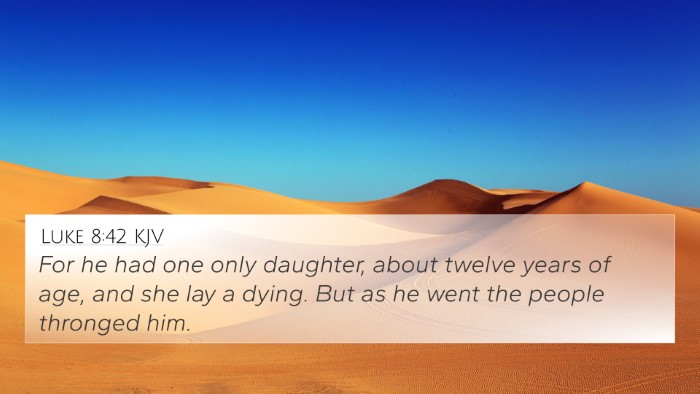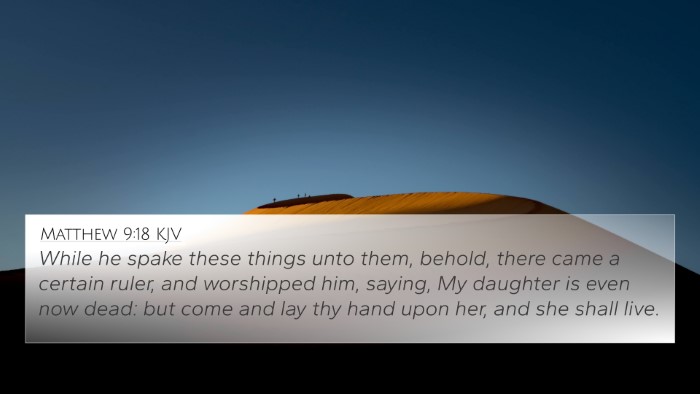Understanding John 4:46
Verse: John 4:46 - "So Jesus came again to Cana of Galilee where He had made the water wine. And there was a certain nobleman whose son was sick at Capernaum."
This verse marks a significant moment in the life of Jesus as He returns to Cana, a place where He performed His first miracle of turning water into wine. The setting reaffirms His authority and abilities, as He now faces a nobleman whose son is critically ill in Capernaum.
Background and Context
John 4:46 captures the second miracle Jesus performed in Cana, emphasizing His divine power and compassion for those in dire need. The nobleman represents those who sought Jesus out of desperation, demonstrating the human tendency to seek help from a higher power when faced with challenges.
Commentary Insights
Matthew Henry's Commentary: Henry notes that Jesus’ return to Cana symbolizes returning to the places where He has already demonstrated His glory. The nobleman seeking Jesus is emblematic of faith, which is crucial for receiving divine blessings. His son's illness illustrates the frailty of human life and the need for divine intervention.
Albert Barnes' Commentary: Barnes highlights that the nobleman was likely a royal official, indicating that even those in positions of authority are subject to trials and tribulations. He posits that the nobleman's faith came from hearing about Jesus' previous miracle and this instigated his desperate search for help.
Adam Clarke's Commentary: Clarke elaborates on the geographic significance, linking Capernaum's location to the narrative context. He examines the nobleman's status and how societal ranks do not prevent one from facing life's adversities. The nobleman's request for healing shows a transition toward faith, suggesting a broader theme of belief in Jesus’ power.
Thematic Connections
The themes present in John 4:46 resonate throughout scripture, offering potential cross-references which enrich understanding and context:
- John 2:1-11 - The miracle at the wedding in Cana highlights Jesus' divine authority.
- Matthew 8:5-13 - The healing of the centurion's servant shows a similar theme of faith and healing from afar.
- Luke 7:1-10 - The account of another centurion and his servant offers comparative insights on faith and authority.
- James 5:14-15 - Calling on the elders for prayer and healing reflects the need for faith in divine intervention.
- Mark 9:23 - "All things are possible to him who believes," reinforcing the importance of faith.
- John 11:1-44 - The raising of Lazarus underscores Jesus' power over life and death, correlating with His healing capabilities.
- Matthew 17:14-21 - Jesus demonstrates faith's role in healing, drawing parallels to the nobleman's plea.
Exploring Inter-Biblical Dialogues
These references establish connections between Bible verses, showing the importance of examining scriptural texts in relation to one another. The healing narratives across the Gospels provide a rich tapestry for understanding faith, the nature of Jesus, and God's response to human suffering.
Conclusion
Understanding John 4:46 requires an appreciation of the surrounding narratives and an acknowledgment of the essential role that faith plays in experiences of healing and divine intervention. The themes of desperation, faith, and the authority of Jesus interweave through this verse and its cross-references, creating a profound exploration of biblical truths.
Additional Study Tools for Cross-Referencing
For those looking to dive deeper into how Bible verses connect, consider utilizing a Bible concordance or a cross-reference Bible study guide. These tools allow for a structured approach to understanding how various scriptures interact with one another.
Keywords and Research Guidance
Primary Keywords: Bible verse cross-references, Connections between Bible verses, Linking Bible scriptures, Comparative Bible verse analysis, Bible verses that relate to each other, Cross-referencing Biblical texts, Thematic Bible verse connections, Bible verse parallels, Scriptural cross-referencing, Inter-Biblical dialogue.
Secondary Keywords: Tools for Bible cross-referencing, Bible concordance, Bible cross-reference guide, Cross-reference Bible study, How to use Bible cross-references, Bible cross-reference system, Cross-referencing Bible study methods, Bible reference resources, Bible chain references, Comprehensive Bible cross-reference materials.
Long-Tail Keywords: How to find cross-references in the Bible, Identifying connections between Old and New Testament, Detailed cross-reference between Gospels, Bible verses related to [specific theme], Cross-referenced themes in the Bible, Comparative study of Pauline epistles, Links between the Prophets and Apostolic teachings, Cross-referencing Psalms with New Testament teachings, Bible cross-references for sermon preparation, Interpreting Biblical themes through cross-references.
User Intent Keywords: What verses are related to [specific Bible verse], Find cross-references for [specific Bible verse], How do [two specific Bible verses] connect, Similarities between [Bible verse] and [Bible verse], Bible verses that support [specific Bible verse].













